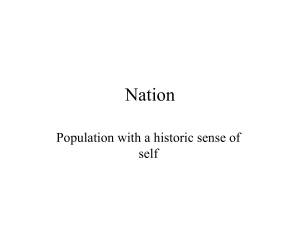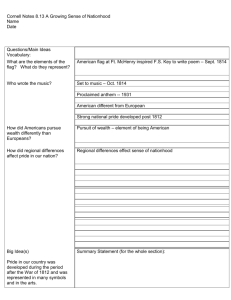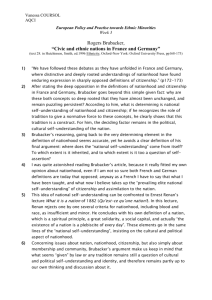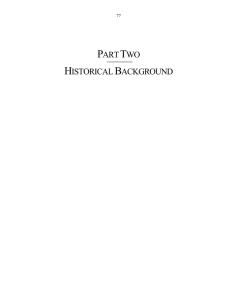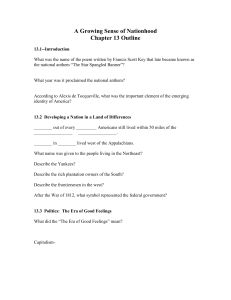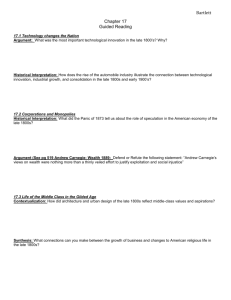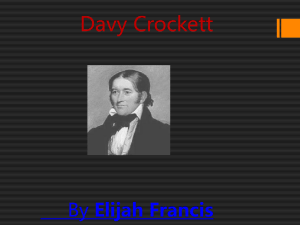A Growing Sense of Nationhood On a separate piece of paper,
advertisement
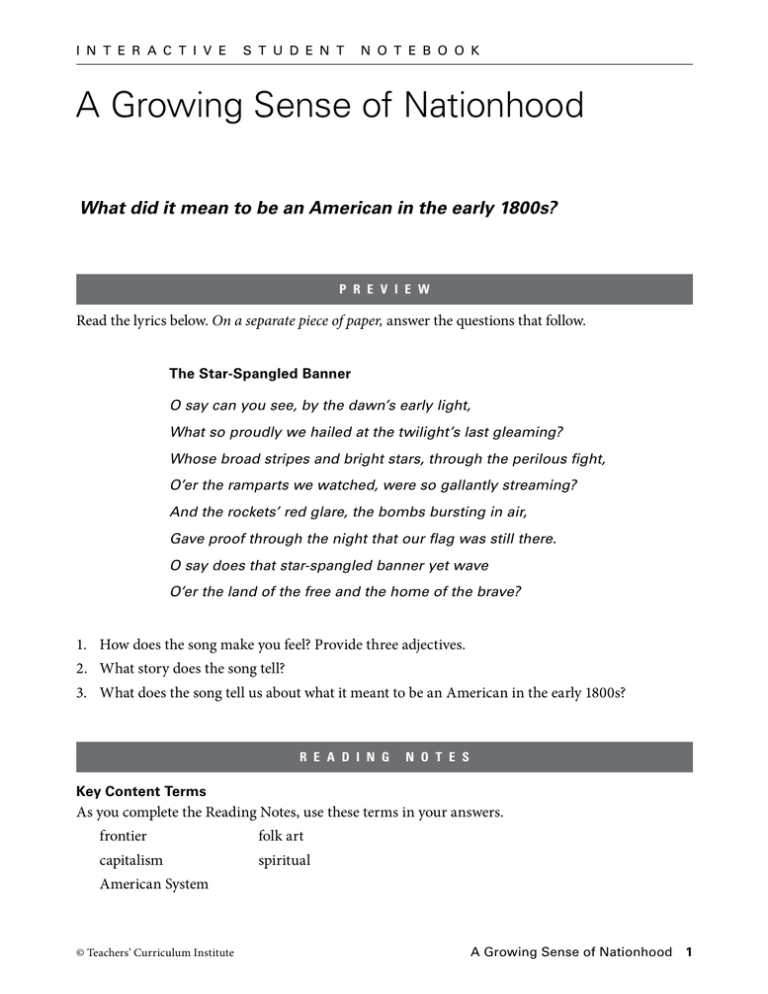
i n t e r a c t i v e s t u d e n t n o t e b o o k A Growing Sense of Nationhood What did it mean to be an American in the early 1800s? P R E V I E W Read the lyrics below. On a separate piece of paper, answer the questions that follow. The Star-Spangled Banner O say can you see, by the dawn’s early light, What so proudly we hailed at the twilight’s last gleaming? Whose broad stripes and bright stars, through the perilous fight, O’er the ramparts we watched, were so gallantly streaming? And the rockets’ red glare, the bombs bursting in air, Gave proof through the night that our flag was still there. O say does that star-spangled banner yet wave O’er the land of the free and the home of the brave? 1. How does the song make you feel? Provide three adjectives. 2. What story does the song tell? 3. What does the song tell us about what it meant to be an American in the early 1800s? R e a d i n g N o t e s Key Content Terms As you complete the Reading Notes, use these terms in your answers. frontier folk art capitalism spiritual American System © Teachers’ Curriculum Institute A Growing Sense of Nationhood 1 i n t e r a c t i v e s t u d e n t n o t e b o o k Section 2 1. Describe three characteristics of life in the early 1800s. 2. Create an illustration that highlights an American symbol or value of the period. For example, you might draw a frontier settler in the wilderness to represent individualism. Write a sentence explaining your illustration. Section 3 1. Complete the spoke diagram showing the main components of Henry Clay’s American System. Federal spending on transportation projects American System 2. Give an example of how decisions by the Supreme Court, under Chief Justice John Marshall, strengthened federal power. © Teachers’ Curriculum Institute A Growing Sense of Nationhood 2 i n t e r a c t i v e s t u d e n t n o t e b o o k Section 4 If your class is doing the activity for this lesson, complete the entire matrix below. (Note: If your class is not doing the activity, fill in only the first two columns.) Read Section 4 and complete the second and third columns of the matrix. Then, as you visit each placard, determine which style or artist the placard relates to, and fill in the remaining information for that row. Early 1800s Style or Artist Two Characteristics of This Style or Artist Draw a Symbol to Represent This Style or Artist Placard Letter and Why You Chose It What Makes This Piece American Folk Art Portraits Hudson River School John James Audubon George Catlin © Teachers’ Curriculum Institute A Growing Sense of Nationhood 3 i n t e r a c t i v e s t u d e n t n o t e b o o k Section 5 1. Complete the spoke diagram of popular early American music. In the ovals, list the four types of music described in the section. (One is given for you.) On each spoke, write a characteristic of that type of music. Classical music Types of Early American Music 2. Use information from Section 5 to describe what this painting shows. © Teachers’ Curriculum Institute A Growing Sense of Nationhood 4 i n t e r a c t i v e s t u d e n t n o t e b o o k Section 6 If your class is doing the activity for this lesson, complete the entire matrix below. (Note: If your class is not doing the activity, fill in only the first two columns.) As you read Section 6, complete the second and third columns of the matrix. Then read each literature excerpt with your group to determine its author, and record your answer. Finally, complete the last column. Early 1800s Author One Work by the Author One Characteristic of Author’s Works Matching Excerpt Letter and Why You Chose It What Makes This Excerpt American Washington Irving James Fenimore Cooper Davy Crockett Henry Wadsworth Longfellow © Teachers’ Curriculum Institute A Growing Sense of Nationhood 5 i n t e r a c t i v e s t u d e n t n o t e b o o k P R O C E SS I NG Read part of the short story “Bear Hunting in Tennessee” by Davy Crockett. In the fall of 1825, I concluded I would build two large boats, and load them with pipe staves [narrow strips of wood] for market. So I went down to the lake, which was about twenty-five miles from where I lived, and hired some hands [workers] to assist me, and went to work; some at boat building, and others to getting staves. I worked on with my hands till the bears got fat, and then I turned out to hunting, to lay in a supply of meat. I soon killed and salted down as many as were necessary for my family; but about this time one of my old neighbours, who had settled down on the lake about twenty-five miles from me, came to my house and told me he wanted me to go down and kill some bears about in his parts. He said they were extremely fat, and very plenty. I know’d that when they were fat, they were easily taken, for a fat bear can’t run fast or long. But I asked a bear no favours, no way, further than civility [politeness], for I now had eight large dogs . . . so that a bear stood no chance at all to get away from them. So I went home with him, and then went on down towards the Mississippi, and commenced hunting. Writing from the perspective of Davy Crockett, complete this short story about hunting bears. Do your writing on another sheet of paper. Remember that Crockett tended to exaggerate to make his stories more entertaining. Your story should bring out details of what it meant to be an American living on the frontier. Your piece should be at least two paragraphs long and free of spelling and grammatical errors. It should also include • at least three details describing frontier life. • a statement on what it means to be an American in the early 1800s. © Teachers’ Curriculum Institute A Growing Sense of Nationhood 6 i n t e r a c t i v e s t u d e n t n o t e b o o k R E AD I NG F U R T H E R Preparing to Write: Analyzing Characters in Literature Rip Van Winkle and Natty Bumppo are famous characters in American literature. Washington Irving and James Fenimore Cooper created them to show a time of change in the young United States. Adjectives are an important component of an author’s toolkit for creating a character. List four adjectives that describe Rip Van Winkle. What was changing in Rip Van Winkle’s world? In a story or novel, the author puts characters in situations that make a point. What point did Cooper want to make in the scene of settlers shooting pigeons? What was changing in Natty Bumppo’s world? © Teachers’ Curriculum Institute A Growing Sense of Nationhood 7 i n t e r a c t i v e s t u d e n t n o t e b o o k Writing a Character Description Suppose you wanted to write a story about change in the United States today. For example, how is technology changing our lives? How is the environment changing? Describe the changes you would like to write about. Create a character to include in your story. Write a description of your character. Describe one situation you would create for your character. It should make a point about change. Use this rubric to evaluate your descriptions. Make changes in them if you need to. Score Description 3 The descriptions give clear details. The situation makes a clear point about change. There are no spelling or grammar errors. 2 The descriptions give some details. The situation makes a point about change. There are some spelling or grammar errors. 1 The descriptions do not give details. The situation does not make a point about change. There are many spelling or grammar errors. © Teachers’ Curriculum Institute A Growing Sense of Nationhood 8
